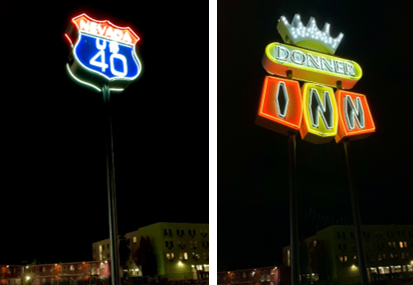Nine Historic Neon Signs for Reno’s Neon Line District

YESCO Completes Restoration, Fabrication, Installation of Nine Historic Signs for Reno’s Neon Line District
Click Here for Downloadable Photos
RENO, NEVADA (December 2020) – YESCO, the 100-year-old Salt Lake City-headquartered company known for creating internationally recognizable signs, recently designed, fabricated, and installed nine historic neon signs in Reno’s Neon Line District. YESCO was retained by development company Jacobs Entertainment for the project to preserve and protect signage from Reno’s historic West Fourth Street corridor. YESCO’s installation marks the end of phase two of Reno’s Neon Line as planned by Jacobs Entertainment. The third and final phase will be completed mid-2021.
Reno’s Neon Line District is an urban, multi-year, mixed-use master-planning effort in downtown Reno, Nevada, encompassing 20 city blocks from West Street to Keystone Avenue, and from Interstate 80 to West Second Street consisting of apartments, condominiums, retail stores, restaurants, art, and neon lighting. The centerpiece of the district is the half-mile-long installation of historic neon tribute signage combined with an LED-lit knee wall and monumental art sculptures.
LIST OF SIGNS:
1) Ramos Drugs Co. – William Ramos opened his first location on Virginia Street in 1928 and operated like any common drugstore. However, Mr. Ramos also offered a soda fountain diner that occupied one side of the store.
2) Nevada U.S. 40 – The Nevada U.S. 40 sign was inspired by the location of the district. Reno’s Neon Line District is located on Fourth Street which, in the past, was the historic Nevada Highway 40.
3) Donner Inn – The Donner Inn, located on U.S. Highway 40, was a 34-unit motel built in 1950 in downtown Reno. The hotel was L-shaped and wrapped around the famous Chapel of the Bells wedding chapel. These attractions enabled the business to prosper for 67 years. The neon sign and crown on top are iconic to Reno’s hotel past.
4) Harold’s Club – Established in 1935, the Harold’s Club was a prestigious casino along Virginia Street in downtown Reno. The owners’ father, Pappy, was the face of the casino. They advertised on over 2,000 billboards across U.S. highways with the slogan “Harold’s Club or Bust!” which helped bring in customers. The casino closed in 1995 and the building was demolished in 1999.
5) Stag Inn – Originally located on North Virginia Street in downtown Reno, the Stag Inn opened in 1933 adjacent to the famous arch that reads “The Biggest Little City in the World.” Primarily a bar, at various times the Stag offered slots, blackjack, craps, roulette, poker and faro. The Stag Inn closed in 1960 and Lincoln Fitzgerald purchased the property.
6) The Downtown Bowl – Located on North Center Street, The Downtown Bowl opened in 1948 and was one of the first of its bowling alley kind, with 12 lanes and an automatic pinsetter in Reno. The lanes opened nightly for a multitude of bowling leagues and was best known for their annual Downtown Bowl Memorial Classic. In 1950, the Truckee River flooded the streets of downtown Reno and The Downtown Bowl was not spared. The Downtown Bowl was able to reopen after shoveling out thick mud and making repairs to the building. The Downtown Bowl stayed open until 1958 when it was purchased by a different company and relocated.
7) El Ray Motel – The El Ray Motel was built in 1964 and was located on Arlington Ave., just two blocks from the heart of downtown Reno and the flashy casino lights and neon along Virginia Street. The motel closed its doors in 2018. The eclectic neon sign is remembered as one of many famous signs that adds to the unique and nostalgic culture of Reno’s past.
8) The Gold Room – Located inside the Golden Bank Casino along famed Virginia Street in downtown Reno, The Gold Room was a successful burlesque club during the 1950s and 1960s. In 1962, an acetylene tank exploded in the basement of the property, completely destroying the hotel and damaging the casino. A year later, the casino and The Gold Room reopened under new ownership. In 1966, the property was sold to William F. Harrah and rebranded as Harrah’s Casino.
9) City Center Motel – The City Center Motel sign on Reno’s Neon Line is the only original sign and was restored by YESCO. The City Center Motel was built in 1957 and located on West Street in Reno, just a couple of blocks away from Reno’s vibrant Virginia Street. The City Center Motel was demolished in 2018.
“We are excited to be part of the revitalization of downtown Reno,” said Jeff Young, senior vice president and chief marketing officer, YESCO. “It’s gratifying to know our work will be viewed by visitors for years to come.”
FUN FACTS:
- Eight of the nine signs on Reno’s Neon Line are tribute signs and were designed and fabricated to look like the originals in a tribute to Reno’s history.
- The Nevada U.S. 40 sign was inspired by the location of the Neon Line district on Fourth Street, just past historic Nevada Highway 40.
- Reno’s Neon Line District neon sign project took YESCO more than 2071 man-hours to complete.
- YESCO worked over 208 hours to install the tape lighting portion of the project.
